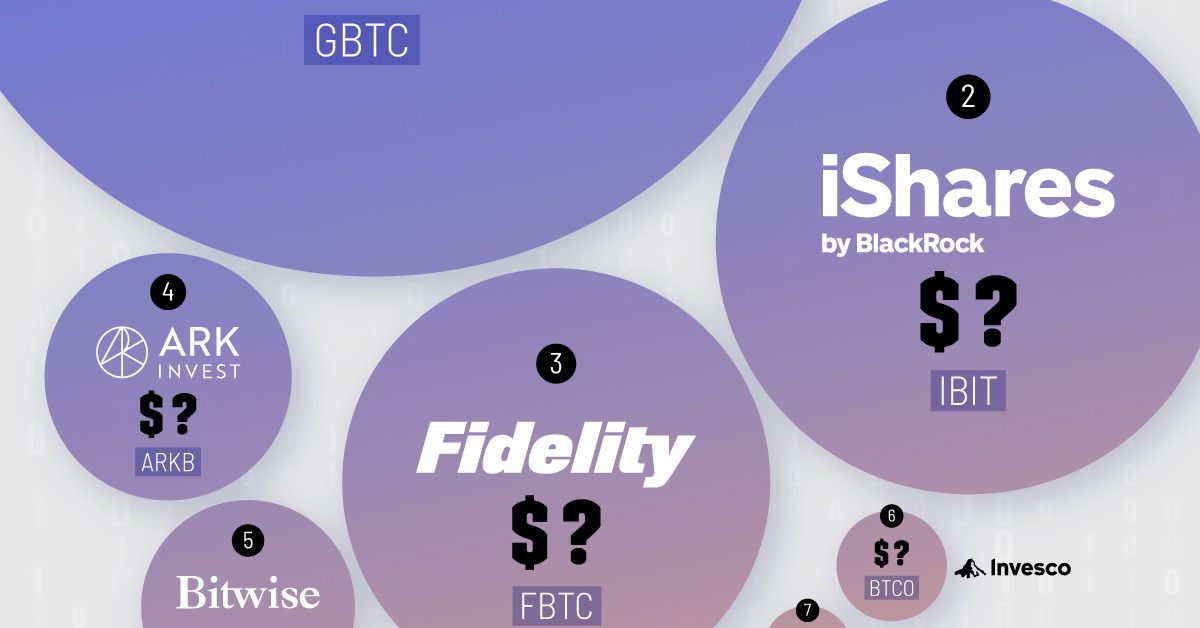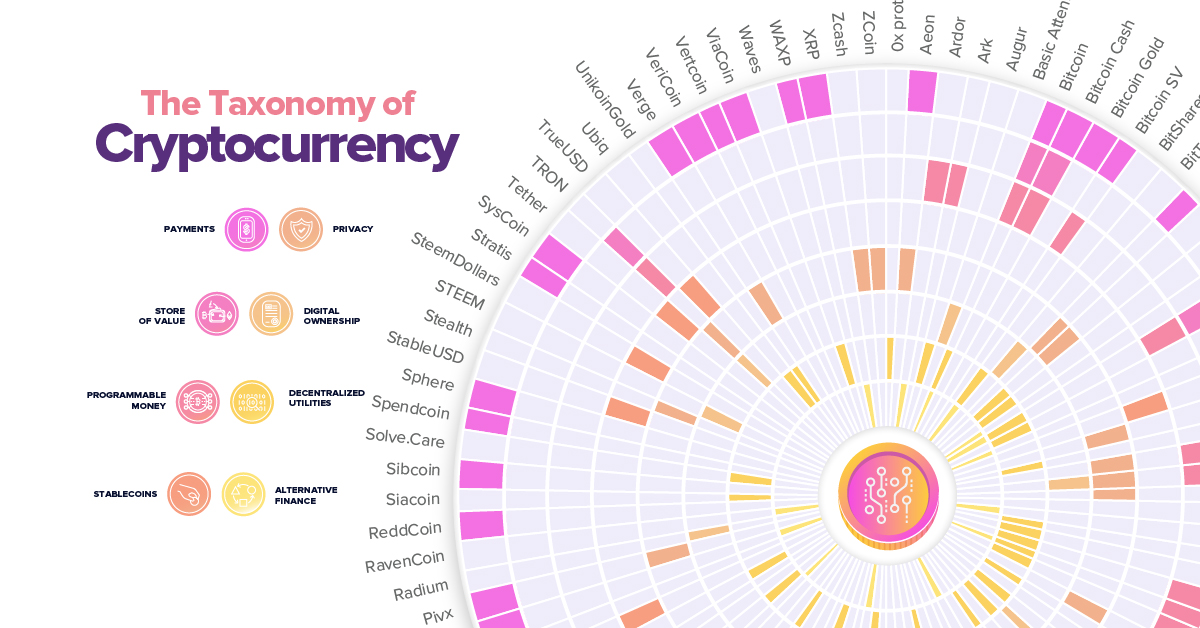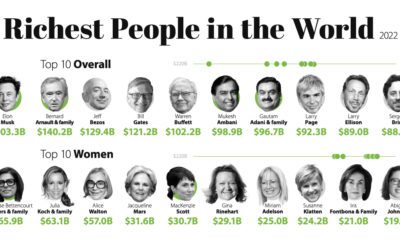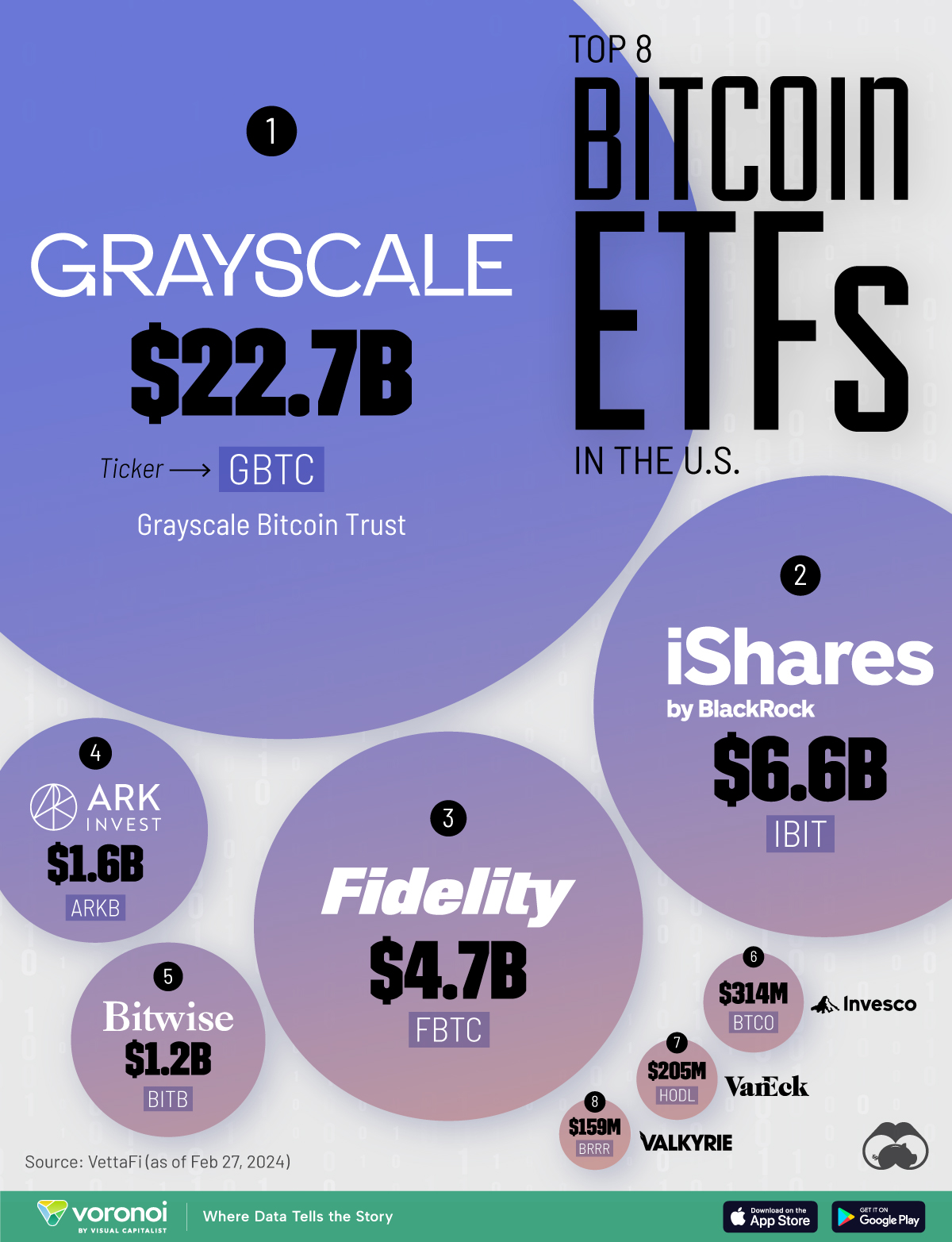Cryptocurrency
Visualizing the New Cryptocurrency Ecosystem

Visualizing the New Cryptocurrency Economy
Over a decade ago, the birth of Bitcoin sparked a revolution in the digital world — and just last year, the number of active cryptocurrencies jumped from roughly 1,600 to over 3,000 worldwide.
Cryptocurrencies have now evolved past simple digital currencies, offering solutions to meet the complex needs of modern financial markets.
Today’s graphic from Abra visualizes the complex, ever-evolving cryptocurrency ecosystem and its real-world applications.
Characteristics of Cryptocurrencies
Why are cryptocurrencies important for the future of digital finance?
- Borderless
Drastically reduces fees and processing times due to a lack of cross-border restrictions - Censorship-free
Prevents governments or major institutions from blocking financial activities at whim - Greater financial control
Individuals can have total control of their funds - Greater security
Prevents fraudulent alterations from third parties - Lower costs
Lower transaction fees thanks to fewer third parties - Greater Accessibility
Reduces or eliminates traditional barriers to capital markets
Much like the internet has forever altered how we live and work, cryptocurrencies have the potential to change how people participate in global financial markets.
Categorizing the New Crypto Economy
Today’s cryptocurrencies go beyond replacing cash. This new token-based economy is evolving─with unique solutions emerging in finance, security, identification, social engagement, and ownership.
Cryptocurrencies are generally categorized by their primary application within the ecosystem:
- Payments
Digital cash can be used for both ecommerce and brick-and-mortar retailers - Store of value
New form of scarce native currency and a means of settlement - Programmable money
Borderless money that enables easy conversion between currencies - Stablecoins
Crypto version of fiat which is tied to the value of resources like gold or the U.S. dollar - Privacy
Private digital transactions, with some offering anonymity - Digital ownership
Digital handling, storage, and monetization of data - Decentralized utilities
Crypto-enabled networks, products, and services that exchange between assets - Alternative finance
Digital assets such as collectibles, commodities, and tokenized securities
Cryptocurrencies are adding both value and utility to the digital economy, and to the global financial market as a whole.
Applications of Cryptocurrencies
Because cryptocurrencies are programmable, customizable computer code, developers can design and adapt them for many use cases within the digital economy.
How are these various cryptocurrencies being used in everyday applications?
Current Projects
- SPEDN auto-converts crypto to fiat for merchants, reducing exchange rate risk while offering convenient customer payment options.
- Slice offers real estate investing to anyone for as low as $10,000 through fractional investment.
Near-future Projects
- CyClean plans to launch a blockchain-enabled electric vehicle (EV) fleet that mines crypto as users travel—reducing emissions and rewarding users for doing so.
- Digital construction platform Builderium connects contractors to clients around the world through blockchain, opening up a global marketplace of potential deals.
These are just a few of the ways cryptocurrencies are breaking down barriers for people and companies worldwide—allowing them to grow personal wealth and enter the global market.
The Growth of the Crypto Economy
Worldwide, the numbers show that blockchain-based technology and cryptocurrency use is growing. Blockchain wallet users rose from nearly 9 million in 2016 to over 42 million in 2019.
Developers produced a mere 100 decentralized apps (DApps) in 2015─with that number skyrocketing to over 3,100 by 2019.
Overall, cryptocurrencies are helping to create an innovative and accessible financial system around the world.
Cryptocurrency deserves an opportunity to find a sustainable future in our economy.
—Adena Friedman, President & CEO of NASDAQ
While the future of the new cryptocurrency economy is still taking shape, one thing is certain─cryptos are forever altering the way we view and measure the value of money.
Technology
Ranked: The Largest Bitcoin ETFs in the U.S.
In this graphic, we rank the top eight Bitcoin ETFs in the U.S. by their total assets under management (AUM).

Ranking the Largest Bitcoin ETFs in the U.S.
This was originally posted on our Voronoi app. Download the app for free on iOS or Android and discover incredible data-driven charts from a variety of trusted sources.
In early January 2024, the U.S. Securities and Exchange Commission (U.S. SEC) gave its approval on exchange-traded funds (ETFs) to track Bitcoin, giving investors an alternative pathway to accessing the world’s biggest cryptocurrency.
In this graphic, we’ve shown the eight largest Bitcoin ETFs in the U.S. by assets under management (AUM), as of Feb. 27, 2024. To elaborate, these are ETFs that buy and hold actual Bitcoin, meaning their performance will generally follow that of Bitcoin itself.
The data used to create this graphic was sourced from VettaFi.
| ETF Name | Ticker | AUM |
|---|---|---|
| Grayscale Bitcoin Trust | GBTC | $22.7B |
| iShares Bitcoin Trust Registered | IBIT | $6.6B |
| Fidelity Wise Origin Bitcoin Fund | FBTC | $4.7B |
| ARK 21Shares Bitcoin ETF | ARKB | $1.6B |
| Bitwise Bitcoin ETF Trust | BITB | $1.2B |
| Invesco Galaxy Bitcoin ETF | BTCO | $314M |
| VanEck Bitcoin Trust | HODL | $205M |
| Valkyrie Bitcoin Fund | BRRR | $159M |
From these numbers we can see that Grayscale’s Bitcoin Trust (GBTC) is the largest by a wide margin. As its name implies, GBTC was originally structured as a trust, but was converted to an ETF on Jan. 11, 2024.
Why Buy a Bitcoin ETF?
Bitcoin ETFs simplify the process of buying and storing Bitcoin. This is because they can be purchased within a traditional brokerage account, just like any other ETF or stock.
Instead of having to think about creating a wallet, memorizing a 12-word seed phrase and holding their keys, this product scraps all of that and provides a well-known path: buy an ETF. This will open the digital asset space to a broader investor base.
Rita Martins, former Head of FinTech Partnerships, HSBC
Investors should be aware that these ETFs charge an expense ratio, which could eat into returns. Information on fees can be easily found on each asset manager’s relevant fund page.
For more visualizations related to Bitcoin, consider this graphic which shows how Bitcoin has performed relative to other major asset classes over the past 10 years.
-

 Debt1 week ago
Debt1 week agoHow Debt-to-GDP Ratios Have Changed Since 2000
-

 Markets2 weeks ago
Markets2 weeks agoRanked: The World’s Top Flight Routes, by Revenue
-

 Countries2 weeks ago
Countries2 weeks agoPopulation Projections: The World’s 6 Largest Countries in 2075
-

 Markets2 weeks ago
Markets2 weeks agoThe Top 10 States by Real GDP Growth in 2023
-

 Demographics2 weeks ago
Demographics2 weeks agoThe Smallest Gender Wage Gaps in OECD Countries
-

 United States2 weeks ago
United States2 weeks agoWhere U.S. Inflation Hit the Hardest in March 2024
-

 Green2 weeks ago
Green2 weeks agoTop Countries By Forest Growth Since 2001
-

 United States2 weeks ago
United States2 weeks agoRanked: The Largest U.S. Corporations by Number of Employees















